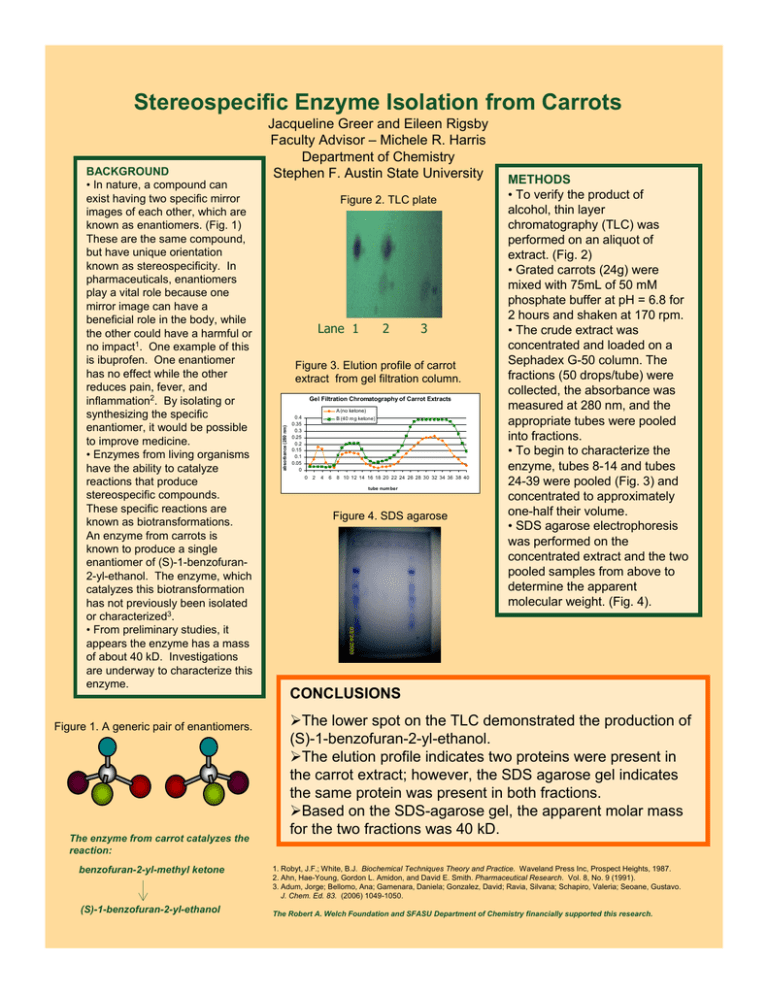Stereospecific Enzyme Isolation from Carrots
advertisement

Stereospecific Enzyme Isolation from Carrots Figure 1. A generic pair of enantiomers. The enzyme from carrot catalyzes the reaction: benzofuran-2-yl-methyl ketone (S)-1-benzofuran-2-yl-ethanol Figure 2. TLC plate Lane 1 2 3 Figure 3. Elution profile of carrot extract from gel filtration column. Gel Filtration Chromatography of Carrot Extracts A (no ketone) absorbance (280 nm) BACKGROUND • In nature, a compound can exist having two specific mirror images of each other, which are known as enantiomers. (Fig. 1) These are the same compound, but have unique orientation known as stereospecificity. In pharmaceuticals, enantiomers play a vital role because one mirror image can have a beneficial role in the body, while the other could have a harmful or no impact1. One example of this is ibuprofen. One enantiomer has no effect while the other reduces pain, fever, and inflammation2. By isolating or synthesizing the specific enantiomer, it would be possible to improve medicine. • Enzymes from living organisms have the ability to catalyze reactions that produce stereospecific compounds. These specific reactions are known as biotransformations. An enzyme from carrots is known to produce a single enantiomer of (S)-1-benzofuran2-yl-ethanol. The enzyme, which catalyzes this biotransformation has not previously been isolated or characterized3. • From preliminary studies, it appears the enzyme has a mass of about 40 kD. Investigations are underway to characterize this enzyme. Jacqueline Greer and Eileen Rigsby Faculty Advisor – Michele R. Harris Department of Chemistry Stephen F. Austin State University 0.4 0.35 0.3 0.25 0.2 0.15 0.1 0.05 0 B (40 mg ketone) 0 2 4 6 8 10 12 14 16 18 20 22 24 26 28 30 32 34 36 38 40 tube num ber Figure 4. SDS agarose METHODS • To verify the product of alcohol, thin layer chromatography (TLC) was performed on an aliquot of extract. (Fig. 2) • Grated carrots (24g) were mixed with 75mL of 50 mM phosphate buffer at pH = 6.8 for 2 hours and shaken at 170 rpm. • The crude extract was concentrated and loaded on a Sephadex G-50 column. The fractions (50 drops/tube) were collected, the absorbance was measured at 280 nm, and the appropriate tubes were pooled into fractions. • To begin to characterize the enzyme, tubes 8-14 and tubes 24-39 were pooled (Fig. 3) and concentrated to approximately one-half their volume. • SDS agarose electrophoresis was performed on the concentrated extract and the two pooled samples from above to determine the apparent molecular weight. (Fig. 4). CONCLUSIONS ¾The lower spot on the TLC demonstrated the production of (S)-1-benzofuran-2-yl-ethanol. ¾The elution profile indicates two proteins were present in the carrot extract; however, the SDS agarose gel indicates the same protein was present in both fractions. ¾Based on the SDS-agarose gel, the apparent molar mass for the two fractions was 40 kD. 1. Robyt, J.F.; White, B.J. Biochemical Techniques Theory and Practice. Waveland Press Inc, Prospect Heights, 1987. 2. Ahn, Hae-Young, Gordon L. Amidon, and David E. Smith. Pharmaceutical Research. Vol. 8, No. 9 (1991). 3. Adum, Jorge; Bellomo, Ana; Gamenara, Daniela; Gonzalez, David; Ravia, Silvana; Schapiro, Valeria; Seoane, Gustavo. J. Chem. Ed. 83. (2006) 1049-1050. The Robert A. Welch Foundation and SFASU Department of Chemistry financially supported this research.



